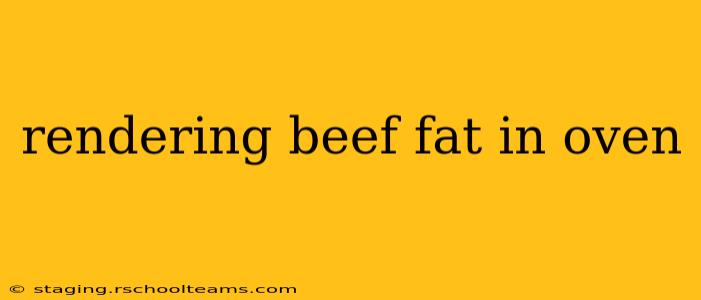Rendering beef fat, also known as making tallow, is a surprisingly simple process that yields a versatile product with numerous culinary and cosmetic uses. This guide will walk you through rendering beef fat in the oven, providing tips and tricks for achieving the best results. Whether you're a seasoned home cook or a beginner, this method offers a convenient and efficient way to transform raw beef fat into valuable tallow.
Why Render Beef Fat?
Before diving into the process, let's explore the benefits of rendering your own beef fat. Many people choose to render their own tallow because:
- High-Quality Ingredient: You control the source and quality of your fat, ensuring it's free from additives and preservatives often found in commercially available products.
- Cost-Effective: Rendering your own tallow is significantly cheaper than purchasing pre-rendered fat.
- Versatile Uses: Tallow can be used in cooking, soap making, and even as a skin moisturizer.
- Reduced Waste: Instead of discarding beef fat, you're transforming it into a valuable resource.
What You'll Need to Render Beef Fat in the Oven
Gathering the necessary supplies beforehand ensures a smooth and efficient rendering process. You will need:
- Beef Fat: Approximately 2-3 pounds of beef fat, preferably from suet (the hard fat found around the kidneys and loins) or other high-quality cuts. Avoid fat with excessive connective tissue or gristle.
- Baking Sheet: A large, rimmed baking sheet to contain any spills.
- Parchment Paper (Optional): Makes cleanup significantly easier.
- Large Bowl or Container: For straining the rendered tallow.
- Fine-Mesh Sieve or Cheesecloth: For filtering out impurities.
- Heat-Safe Jars: For storing the finished tallow.
How to Render Beef Fat in the Oven: A Step-by-Step Guide
Rendering beef fat in the oven is a slow and low-heat process. Follow these steps for optimal results:
-
Preheat Oven to 275°F (135°C): This low temperature ensures slow rendering, preventing burning and maximizing the yield of clear tallow.
-
Prepare the Baking Sheet: Line your baking sheet with parchment paper for easy cleanup. This step isn't strictly necessary, but it's highly recommended.
-
Chop the Beef Fat: Cut the beef fat into 1-inch cubes. Smaller pieces render faster, but too small can lead to burning.
-
Spread the Fat on the Baking Sheet: Arrange the fat cubes in a single layer on the prepared baking sheet, ensuring they aren't overcrowded.
-
Render in the Oven: Place the baking sheet in the preheated oven and bake for 2-3 hours, or until the fat is rendered and golden brown. Check on it periodically, and if it seems to be browning too quickly, lower the oven temperature.
-
Strain the Tallow: Once rendered, carefully remove the baking sheet from the oven (use oven mitts!). Let the mixture cool slightly before carefully pouring it through a fine-mesh sieve or cheesecloth into a large bowl, separating the liquid tallow from the cracklings (crispy bits of rendered fat).
-
Store the Tallow: Pour the strained tallow into heat-safe jars, allowing it to cool and solidify completely. Properly stored tallow can last for a year or more in the refrigerator.
How Long Does it Take to Render Beef Fat in the Oven?
The rendering time depends on several factors, including the amount of fat, the size of the cubes, and your oven's consistency. Generally, it takes between 2-3 hours at 275°F (135°C). However, be patient and check periodically to avoid burning.
Can You Render Beef Fat on the Stovetop?
Yes, rendering beef fat on the stovetop is another popular method. This method is generally faster but requires more attention to prevent burning. It's crucial to use low heat and stir frequently.
What Can I Do With Rendered Beef Fat (Tallow)?
Rendered beef fat, or tallow, has a wide range of uses:
- Cooking: Tallow is excellent for high-heat cooking, adding rich flavor to meats and vegetables.
- Baking: It can be substituted for other fats in baking recipes, creating flaky pastries and tender crusts.
- Soap Making: Tallow is a key ingredient in traditional soap making, contributing to a hard and long-lasting bar.
- Cosmetics: Some people use tallow as a moisturizer or salve for its purported skin-soothing properties.
Conclusion
Rendering beef fat in the oven is a rewarding process that allows you to create a versatile and valuable product from what might otherwise be considered waste. By following these steps and tips, you can successfully render your own high-quality tallow for various culinary and cosmetic uses. Remember patience is key, and the end result is worth the effort.
